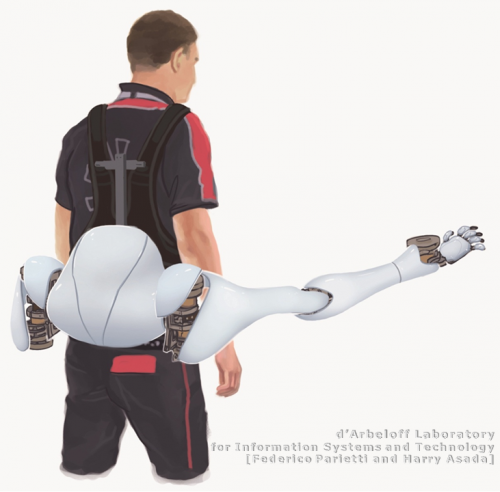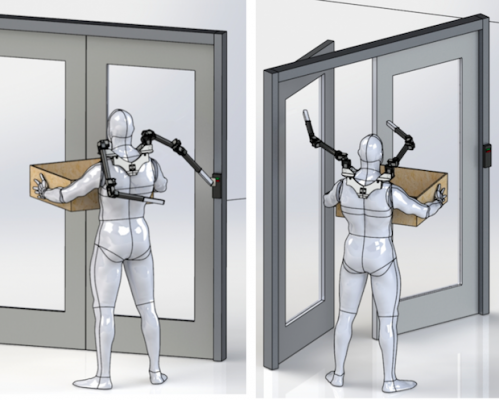June 3, 2014 weblog
MIT lab designs workload-sharing robotic limbs (w/ Video)

Mention "robotic limbs" and one thinks of devices being developed to replace the loss of human limbs. Mention "exoskeleton" and one thinks of a suit governing and bound to the entire body. Researchers at the d'Arbeloff Laboratory for Information Systems and Technology at MIT, led by Professor Harry Asada, Ford Professor of Engineering, have been breaking ground in another direction. They are working in a co-robot world, and they are developing "extras" for what the person already has. Videos showing people performing tasks tell a story of what future work might look like when an extra set of arms or legs will be of significant help. "Supernumerary Robotic Limbs" (SRLs) is the formal term to describe robotic limbs that, when worn, augment limbs already in place.
"Imagine that one day humans will have a third arm and a third leg attached to their body. The extra limbs will help them hold objects, support the human body, share a workload, and streamline the execution of a task. If the movements of such supernumerary limbs are tightly coupled and coordinated with their arms, the human users may come to perceive the extra limbs as an extension of their own body," the Lab team suggest on their site. "The goal of our work is to build a co-robot that becomes a functional extension of the human body."
In such settings, the extra arm or leg attached to the body helps to hold objects, share workloads, and streamline tasks. Situations might include trying to open a door when you need to keep holding something with both hands or having an extra hand to keep something in place during construction. The devices would look odd on people walking down a city street or at a mall, but the designs deliver practical relevance for a workforce. A note from the Lab's Baldin Llorens and Harry Asada, for example, said, "In the demanding manufacturing industry, Human-Robot collaboration has proved to be a strong alternative when it comes to tasks that cannot be fully automated." To optimize productivity, the robots in their designs serve to complement, not replace, human actions. The human worker perceives the robot not as machine but as body extension.
In an aircraft assembly scenario, the Laboratory presents an example where the SRLs are coordinated with the workers to help execute specialized aircraft assembly tasks. "We focus on the task planning process, communication and coordination between the human worker and the SRL and control implementation."
Evan Ackerman, reporting on their work in IEEE Spectrum, explained what goes into that communication between human and extra limb. How do these robotic limbs know what to do? Ackerman said "the SRL watches what you're doing with your arms to decide how to move. It does that by monitoring two inertial measurement units (IMUs) that the user wears on the wrists. A third IMU sits at the base of the robot's shoulder mount, to track the overall orientation and motion of the SRL."
With the gyro and accelerometer data, the limb can predict, based on a model created by demonstration learning, the helpful arm position. If the person raises arms above the head, the SRLs go above the head too, seeing signs that the person is trying to hold something up. "Using their SRL prototype," said Ackerman, "the researchers are testing different 'behavioral modes' to program the limbs to do what they want."

One model has limbs springing from the shoulders for tasks that take place over the head. Other constructs involve waist-mounted SRLs that can be used as two extra arms, two extra legs, or one of each.
MIT researchers were in Hong Kong at the IEEE International Conference on Robotics and Automation (ICRA) on Monday, said Ackerman, where they presented SRL prototypes.
More information: SRL Concept and Design: darbelofflab.mit.edu/?q=node/22
© 2014 Tech Xplore




















